Epson DLQ-3000 User Manual
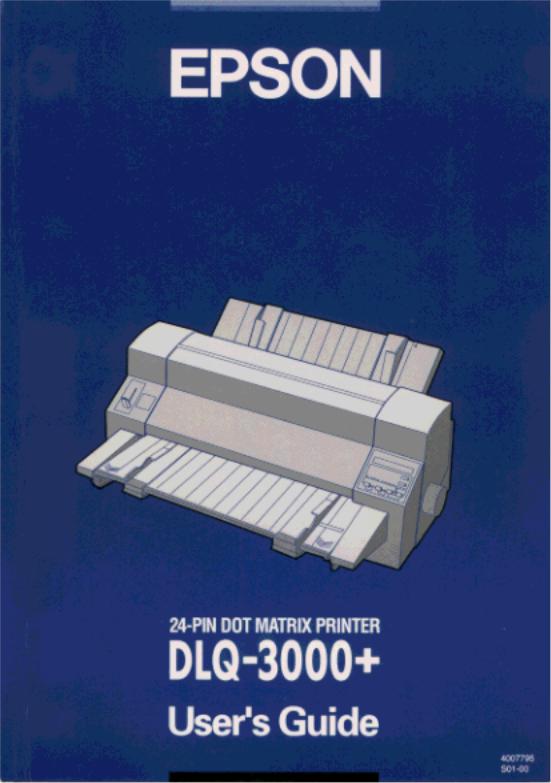
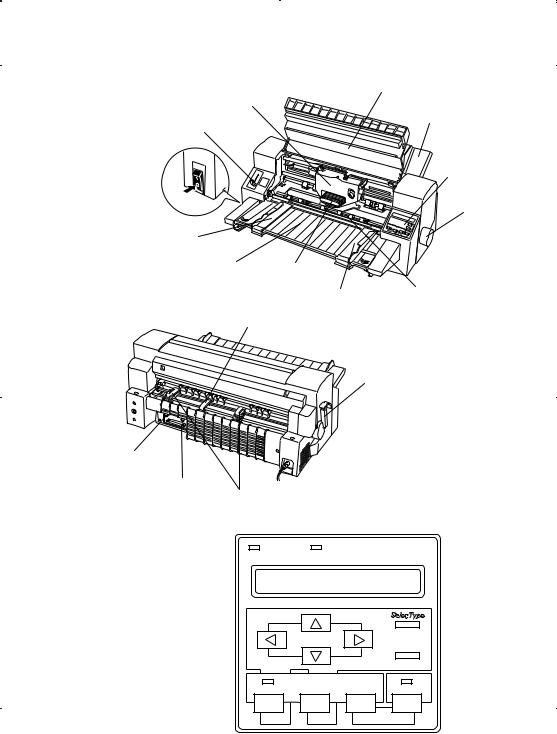
Printer Parts
printer cover
ribbon cartridge
rear paper guide
paper thickness lever


 control panel power switch
control panel power switch 
OFF
knob
left edge guide
front paper guide
print head
paper bail
right edge guide
center paper support*
paper release lever
parallel interface |
|
|
serial interface |
sprocket units* |
* tractor unit parts |
|
||
|
|
Control Panel
Power |
Paper Out |
Paper Select
Tear Off |
LF/FF |
Load/Eject |
Pause |
Font |
Pitch |
Reset |
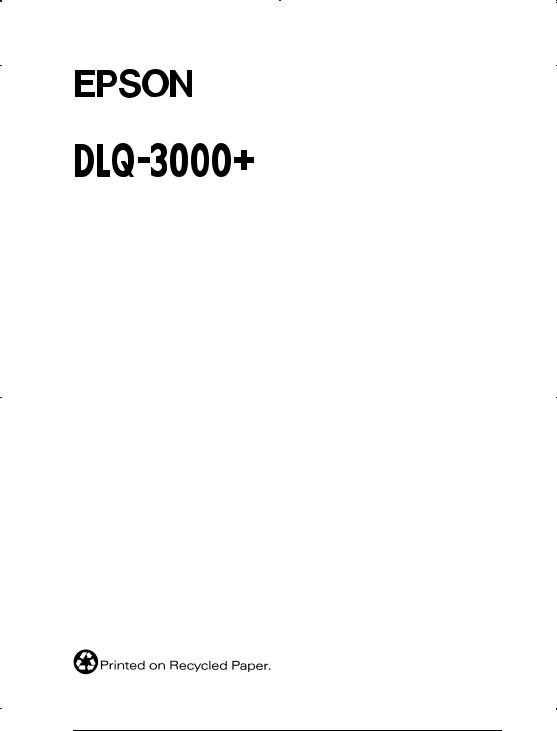
®
24-Pin Dot Matrix Printer
All rights reserved. No part of this publication may be reproduced, stored in a retrieval system, or transmitted in any form or by any means, electronic, mechanical, photocopying, recording, or otherwise, without the prior written permission of SEIKO EPSON CORPORATION. The information contained herein is designed only for use with this EPSON printer. EPSON is not responsible for any use of this information as applied to other printers.
Neither SEIKO EPSON CORPORATION nor its affiliates shall be liable to the purchaser of this product or third parties for damages, losses, costs, or expenses incurred by the purchaser or third parties as a result of: accident, misuse, or abuse of this product or unauthorized modifications, repairs, or alterations to this product, or (excluding the U.S.) failure to strictly comply with SEIKO EPSON CORPORATION’s operating and maintenance instructions.
SEIKO EPSON CORPORATION shall not be liable for any damages or problems arising from the use of any options or any consumable products other than those designated as Original EPSON Products or EPSON Approved Products by SEIKO EPSON CORPORATION.
EPSON and EPSON ESC/P are registered trademarks and EPSON ESC/P 2 is a trademark of SEIKO EPSON CORPORATION.
Microsoft and Windows are registered trademarks of Microsoft Corporation.
IBM is a registered trademark of International Business Machines Corporation.
General Notice: Other product names used herein are for identification purposes only and may be trademarks of their respective owners. EPSON disclaims any and all rights in those marks.
Copyright © 1997 by SEIKO EPSON CORPORATION, Nagano, Japan.
User’s Guide

Declaration of Conformity
According to ISO/IEC Guide 22 and EN 45014
Manufacturer: |
SEIKO EPSON CORPORATION |
Address: |
3-5, Owa 3-chome, Suwa-shi, |
|
Nagano-ken 392 Japan |
Representative: |
EPSON EUROPE B.V. |
Address: |
Prof. J. H. Bavincklaan 5 1183 AT Amstelveen |
|
The Netherlands |
Declares that the Product: |
|
Product Name: |
Dot Matrix Printer |
Model: |
P821A |
Conforms to the following Directive(s) and Norm(s):
Directive 73/23/EEC:
EN 60950
Directive 89/336/EEC:
EN 55022 Class B
EN 61000-3-2
EN 61000-3-3
EN 50082-1
IEC 801-2
IEC 801-3
IEC 801-4
August 1997
Y. Ishii
President of EPSON EUROPE B.V.
ii
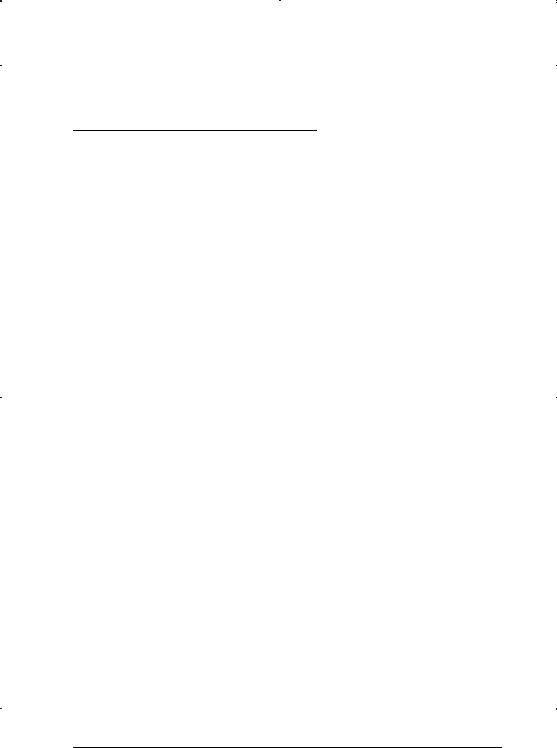
Safety Information
Important Safety Instructions
Read all of these instructions and save them for later reference. Follow all warnings and instructions marked on the printer.
Do not place the printer on an unstable surface or near a radiator or heat source.
Place the printer on a flat surface. The printer will not operate properly if it is tilted or at an angle.
Do not block or cover the openings in the printer’s cabinet. Do not insert objects through the slots.
Use only the type of power source indicated on the printer’s label.
Connect all equipment to properly grounded power outlets. Avoid using outlets on the same circuit as photocopiers or air control systems that regularly switch on and off.
Do not use a damaged or frayed power cord.
If you use an extension cord with the printer, make sure the total ampere rating of all devices plugged into the extension cord does not exceed the cord’s ampere rating. Also, make sure the total ampere rating of all devices plugged into the wall outlet does not exceed the wall outlet’s ampere rating.
Unplug the printer before cleaning. Clean with a damp cloth only. Do not spill liquid on the printer.
Except as specifically explained in this guide, do not attempt to service the printer yourself.
iii
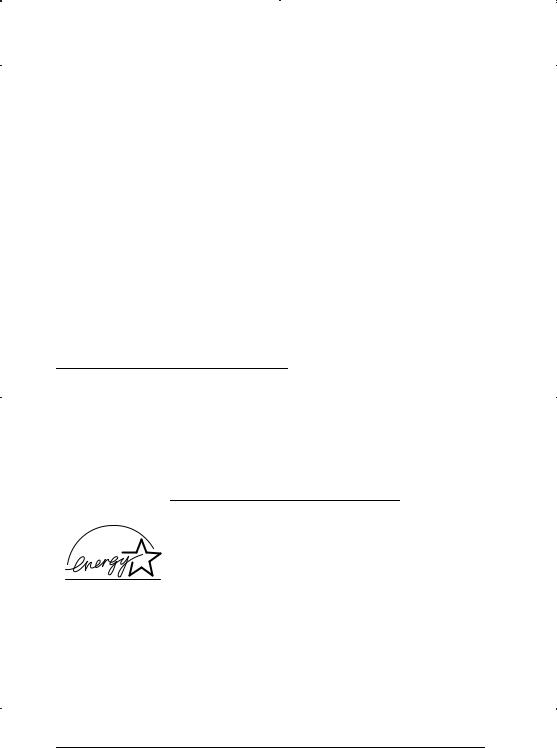
Unplug the printer and refer servicing to qualified service personnel under the following conditions:
If the power cord or plug is damaged; if liquid has entered the printer; if the printer has been dropped or the cabinet damaged;
if the printer does not operate normally or exhibits a distinct change in performance. Adjust only those controls that are covered by the operating instructions.
If you plan to use the printer in Germany, observe the following:
To provide adequate short-circuit protection and over-current protection for this printer, the building installation must be protected by a 16 Amp circuit breaker.
Bei Anschluß des Druckers an die Stromversorgung muß sichergestellt werden, daß die Gebäudeinstallation mit einem 16 A-Überstromschalter abgesichert ist.
Print Head Caution Symbol
The symbol on the print head indicates that this part may
Kbe hot. Never touch the print head just after the printer has been used. Let the print head cool for a few minutes before touching it.
ENERGY STAR Compliance
As an ENERGY STAR Partner, EPSON has determined that this product meets the ENERGY STAR guidelines for energy efficiency.
The International ENERGY STAR Office Equipment program is a voluntary partnership with the computer and office equipment industry to promote the introduction of energy-efficient personal computers, monitors, printers, fax machines, and copiers in an effort to reduce air pollution caused by power generation.
iv

For United Kingdom Users
Use of options
Epson (UK) Limited shall not be liable against any damages or problems arising from the use of any options or consumable products other than those designated as Original EPSON Products or EPSON Approved Products by Epson (UK) Limited.
Safety information
wWarning: This appliance must be earthed. Refer to rating plate for voltage and check that the appliance voltage corresponds to the supply voltage.
Important: The wires in the mains lead fitted to this appliance are coloured in accordance with the following code:
Green and yellow — Earth Blue — Neutral
Brown — Live
If you have to fit a plug:
As the colours of the mains lead of this appliance may not match coloured markings used to identify the terminals in a plug, please proceed as follows:
The green and yellow wire must be connected to the terminal in the plug which is marked with the letter E or the Earth symbol (G).
The blue wire must be connected to the terminal in the plug marked with the letter N.
The brown wire must be connected to the terminal in the plug marked with the letter L.
If damage occurs to the plug, replace the cord set or consult a qualified electrician.
Replace fuses only with a fuse of the correct size and rating.
v
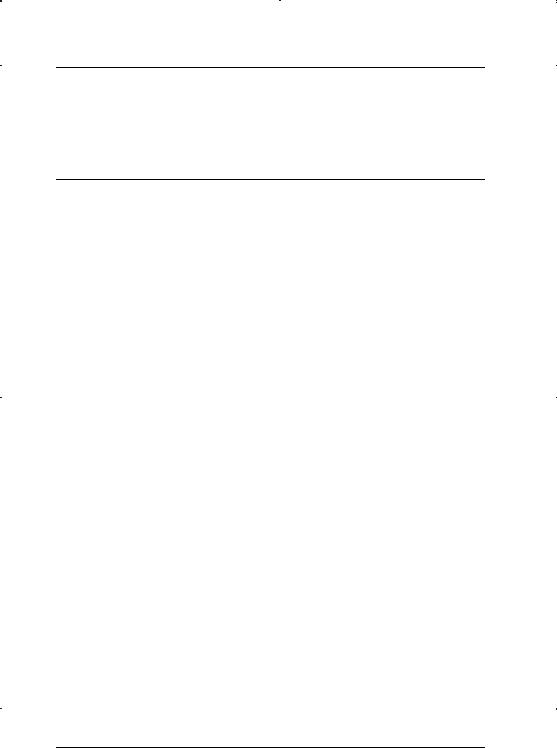
Contents
Introduction
. . .Features |
. . . . . . . . . . . . . . . . . . . . . . . . . . |
. . . . |
0- |
1 |
Options . . . . |
. . . . . . . . . . . . . . . . . . . . . . . . . . |
. . . . |
0- |
2 |
How to Use This Manual . . . . . . . . . . . . . . . . . . . . . |
. . . |
0- |
3 |
|
Warnings, Cautions, and Notes . . . . . . . . . . . . . . . . . |
. . . |
0- |
4 |
|
Chapter 1 |
Setting Up the Printer |
|
|
|
|
|
|
||
|
|
|
|
|
Unpacking the Printer . . . . . . . . . . . . . . . . . . . . . . |
. . . 1-2 |
|||
Choosing a Place for the Printer . . . . . . . . . . . . . . . . . |
. . . 1-3 |
|||
Assembling the Printer . . . . . . . . . . . . . . . . . . . . . . |
. . . 1-5 |
|||
Installing the ribbon cartridge . . . . . . . . . . . . . . . |
. . . 1-5 |
|||
Attaching the paper guides . . . . . . . . . . . . . . . . |
. . . 1-8 |
|||
Plugging In the Printer . . . . . . . . . . . . . . . . . . . . . . |
. . . 1-9 |
|||
Connecting the Printer to Your Computer . . . . . . . . . . . |
. . . 1-10 |
|||
Chapter 2 |
Setting Up Your Software |
|
|
|
|
|
|
|
|
For Windows 95 Users . . . . . . . . . . . . . . . . . . . . . . |
. . . 2-2 |
|||
Installing the printer driver using My Computer . . . . |
. . . 2-2 |
|||
Installing the printer driver using plug-and-play . . . . |
. . . 2-3 |
|||
Using the printer driver . . . . . . . . . . . . . . . . . . |
. . . 2-5 |
|||
Installing EPSON Status Monitor 2 . . . . . . . . . . . . |
. . . 2-8 |
|||
For Windows 3.1 Users . . . . . . . . . . . . . . . . . . . . . . |
. . . 2-9 |
|||
Installing the printer driver using Program Manager |
. . . . 2-9 |
|||
Using the printer driver . . . . . . . . . . . . . . . . . . |
. . . 2-10 |
|||
For Windows NT 4.0 Users . . . . . . . . . . . . . . . . . . . |
. . . 2-13 |
|||
Installing the printer driver . . . . . . . . . . . . . . . . |
. . . 2-13 |
|||
Using the printer driver . . . . . . . . . . . . . . . . . . |
. . . 2-14 |
|||
vi

For Windows NT 3.5x Users . . . . . . . . . . . . . . . . . . . . . . |
2-17 |
|
Installing the printer driver . . . . . . . . . . . . . . . . . . . . |
2-17 |
|
Using the printer driver . . . . . . . . . . . . . . . . . . . . . . |
2-18 |
|
For DOS Program Users . . . . . . . . . . . . . . . . . . . . . . . . |
2-21 |
|
Installing the printer driver . . . . . . . . . . . . . . . . . . . . |
2-21 |
|
Using the printer utilities . . . . . . . . . . . . . . . . . . . . . |
2-22 |
|
Chapter 3 |
Paper Handling |
|
|
|
|
Selecting a Paper-Feeding Method . . . . . . . . . . . . . . . . . . |
3-2 |
|
Paper-feeding methods and paper types . . . . . . . . . . . . |
3-3 |
|
Setting the paper release lever . . . . . . . . . . . . . . . . . . |
3-4 |
|
Adjusting the Paper Thickness Lever . . . . . . . . . . . . . . . . . |
3-5 |
|
Using Single Sheets . . . . . . . . . . . . . . . . . . . . . . . . . . . |
3-7 |
|
Loading single sheets from the front . . . . . . . . . . . . . . |
3-7 |
|
Loading single sheets from the rear . . . . . . . . . . . . . . . |
3-10 |
|
Using Continuous Paper . . . . . . . . . . . . . . . . . . . . . . . . |
3-13 |
|
Positioning your continuous paper supply . . . . . . . . . . . |
3-13 |
|
Loading continuous paper with the tractor . . . . . . . . . . . |
3-14 |
|
Using the tear-off function . . . . . . . . . . . . . . . . . . . . |
3-20 |
|
Removing continuous paper . . . . . . . . . . . . . . . . . . . |
3-23 |
|
Using Special Paper . . . . . . . . . . . . . . . . . . . . . . . . . . . |
3-24 |
|
Multi-part forms . . . . . . . . . . . . . . . . . . . . . . . . . . |
3-24 |
|
Labels . . |
. . . . . . . . . . . . . . . . . . . . . . . . . . . . . . |
3-25 |
Envelopes |
. . . . . . . . . . . . . . . . . . . . . . . . . . . . . . |
3-26 |
Postcards |
. . . . . . . . . . . . . . . . . . . . . . . . . . . . . . |
3-28 |
Overlapping multi-part forms . . . . . . . . . . . . . . . . . . |
3-29 |
|
Continuous forms with labels . . . . . . . . . . . . . . . . . . |
3-31 |
|
Overlapping multi-part forms with labels . . . . . . . . . . . |
3-33 |
|
Switching Between Continuous Paper and Single Sheets . . . . . . |
3-36 |
|
Switching to single sheets . . . . . . . . . . . . . . . . . . . . . |
3-36 |
|
Switching to continuous paper . . . . . . . . . . . . . . . . . . |
3-37 |
|
Using the Micro-Feed Feature . . . . . . . . . . . . . . . . . . . . . |
3-38 |
|
Adjusting the printing position . . . . . . . . . . . . . . . . . |
3-38 |
|
Adjusting the tear-off position . . . . . . . . . . . . . . . . . . |
3-39 |
|
vii

Chapter 4 |
Controlling the Printer |
|
Control Panel |
. . . . . . . . . . . . . . . . . . . . . . . . . . . . . . |
4-2 |
Display . |
. . . . . . . . . . . . . . . . . . . . . . . . . . . . . . |
4-3 |
Lights . . . |
. . . . . . . . . . . . . . . . . . . . . . . . . . . . . |
4-4 |
Buttons . . |
. . . . . . . . . . . . . . . . . . . . . . . . . . . . . |
4-4 |
Other control panel features . . . . . . . . . . . . . . . . . . . |
4-7 |
|
SelecType . . . . |
. . . . . . . . . . . . . . . . . . . . . . . . . . . . . |
4-8 |
SelecType overview . . . . . . . . . . . . . . . . . . . . . . . . |
4-8 |
|
Using SelecType . . . . . . . . . . . . . . . . . . . . . . . . . . |
4-9 |
|
Level 1 options . . . . . . . . . . . . . . . . . . . . . . . . . . . |
4-12 |
|
Level 2 options . . . . . . . . . . . . . . . . . . . . . . . . . . . |
4-15 |
|
Type Styles . . . |
. . . . . . . . . . . . . . . . . . . . . . . . . . . . . |
4-20 |
Character fonts . . . . . . . . . . . . . . . . . . . . . . . . . . |
4-20 |
|
Character spacing . . . . . . . . . . . . . . . . . . . . . . . . . |
4-22 |
|
Printing in Color . . . . . . . . . . . . . . . . . . . . . . . . . . . . |
4-23 |
|
Barcode Printing . . . . . . . . . . . . . . . . . . . . . . . . . . . . |
4-23 |
|
Chapter 5 |
Using EPSON Status Monitor 2 |
|
|
|
|
Opening and Using EPSON Status Monitor 2 . . . . . . . . . . . . |
5-2 |
|
Understanding the EPSON Status Monitor 2 window . . . . |
5-2 |
|
Getting detailed printer status information . . . . . . . . . . |
5-6 |
|
Using the Background Monitoring Feature . . . . . . . . . . . . . |
5-8 |
|
Setting monitoring preferences . . . . . . . . . . . . . . . . . |
5-8 |
|
Using the background monitoring icon . . . . . . . . . . . . |
5-10 |
|
Chapter 6 |
Using Printer Options |
|
|
|
|
Cut-Sheet Feeder . . . . . . . . . . . . . . . . . . . . . . . . . . . . |
6-2 |
|
Installing the cut-sheet feeder . . . . . . . . . . . . . . . . . . |
6-2 |
|
Loading paper with the cut-sheet feeder . . . . . . . . . . . . |
6-5 |
|
Loading paper manually from the front paper guide . . . . . |
6-9 |
|
Switching between the tractor and the cut-sheet feeder . . . |
6-10 |
|
Interface Cards |
. . . . . . . . . . . . . . . . . . . . . . . . . . . . . |
6-11 |
Installing an interface card . . . . . . . . . . . . . . . . . . . . |
6-12 |
|
viii

Chapter 7 |
Maintenance and Transportation |
|
Replacing the Ribbon Cartridge . . . . . . . . . . . . . . . . . . . . |
7-2 |
|
Cleaning the Printer . . . . . . . . . . . . . . . . . . . . . . . . . . . |
7-5 |
|
Transporting the Printer . . . . . . . . . . . . . . . . . . . . . . . . |
7-6 |
|
Chapter 8 |
Troubleshooting |
|
|
|
|
Using the Error Indicators . . . . . . . . . . . . . . . . . . . . . . . |
8-3 |
|
Printing a Self Test . . . . . . . . . . . . . . . . . . . . . . . . . . . . |
8-5 |
|
Using the Hex Dump Mode . . . . . . . . . . . . . . . . . . . . . . |
8-6 |
|
Problems and Solutions . . . . . . . . . . . . . . . . . . . . . . . . . |
8-7 |
|
Power supply |
. . . . . . . . . . . . . . . . . . . . . . . . . . . . . . |
8-8 |
Paper handling . . . . . . . . . . . . . . . . . . . . . . . . . . . |
8-9 |
|
Operation |
. . . . . . . . . . . . . . . . . . . . . . . . . . . . . |
8-17 |
Printout . |
. . . . . . . . . . . . . . . . . . . . . . . . . . . . . . |
8-19 |
Clearing a Paper Jam . . . . . . . . . . . . . . . . . . . . . . . . . . |
8-24 |
|
Using Bidirectional Adjustment Mode . . . . . . . . . . . . . . . . |
8-25 |
|
Appendix A |
Specifications |
|
|
|
|
Technical Specifications . . . . . . . . . . . . . . . . . . . . . . . . . |
A-2 |
|
Printing . |
. . . . . . . . . . . . . . . . . . . . . . . . . . . . . . |
A-2 |
Paper . . |
. . . . . . . . . . . . . . . . . . . . . . . . . . . . . . |
A-4 |
Mechanical . . . . . . . . . . . . . . . . . . . . . . . . . . . . . |
A-15 |
|
Electrical |
. . . . . . . . . . . . . . . . . . . . . . . . . . . . . . |
A-16 |
Environmental . . . . . . . . . . . . . . . . . . . . . . . . . . . |
A-16 |
|
Safety approvals . . . . . . . . . . . . . . . . . . . . . . . . . . |
A-17 |
|
CE marking . . . . . . . . . . . . . . . . . . . . . . . . . . . . . |
A-17 |
|
Parallel Interface Specifications . . . . . . . . . . . . . . . . . . . . |
A-18 |
|
Forward channel . . . . . . . . . . . . . . . . . . . . . . . . . . |
A-18 |
|
Reverse channel . . . . . . . . . . . . . . . . . . . . . . . . . . |
A-18 |
|
Serial Interface Specifications . . . . . . . . . . . . . . . . . . . . . |
A-19 |
|
Optional Cut-Sheet Feeder Specifications . . . . . . . . . . . |
A-19 |
|
ix

Appendix B Command Lists and Character Tables
EPSON ESC/P 2 Control Codes . . . . . . . . . . . . . . . . . . . . |
B-2 |
Barcode command . . . . . . . . . . . . . . . . . . . . . . . . |
B-3 |
IBM 2391 Plus Emulation Control Codes . . . . . . . . . . . . . . |
B-6 |
Character Tables in EPSON ESC/P 2 Mode . . . . . . . . . . . . . |
B-7 |
Appendix C Contacting Customer Support |
|
|
|
For United Kingdom and the Republic of Ireland Users . . . . . . |
C-2 |
Enquiry Desk . . . . . . . . . . . . . . . . . . . . . . . . . . . |
C-3 |
Customer Support . . . . . . . . . . . . . . . . . . . . . . . . . |
C-3 |
Faxon EPSON . . . . . . . . . . . . . . . . . . . . . . . . . . . |
C-3 |
EPtec - Bulletin Board Service for latest drivers and |
|
utilities . . . . . . . . . . . . . . . . . . . . . . . . . . . . . . |
C-4 |
World Wide Web . . . . . . . . . . . . . . . . . . . . . . . . . |
C-4 |
For Australian Users . . . . . . . . . . . . . . . . . . . . . . . . . . |
C-5 |
EPSON FAXBACK . . . . . . . . . . . . . . . . . . . . . . . . |
C-5 |
EPSON Bulletin Board System . . . . . . . . . . . . . . . . . . |
C-5 |
Internet URL http://www.epson.com.au . . . . . . . . . . . |
C-5 |
Your dealer . . . . . . . . . . . . . . . . . . . . . . . . . . . . . |
C-5 |
EPSON Helpdesk . . . . . . . . . . . . . . . . . . . . . . . . . |
C-6 |
For Singapore Users . . . . . . . . . . . . . . . . . . . . . . . . . . |
C-6 |
For Hong Kong Users . . . . . . . . . . . . . . . . . . . . . . . . . |
C-7 |
Internet home page . . . . . . . . . . . . . . . . . . . . . . . . |
C-7 |
Electronic bulletin board system . . . . . . . . . . . . . . . . |
C-7 |
Technical Support Hotline . . . . . . . . . . . . . . . . . . . . |
C-7 |
For Philippines Users . . . . . . . . . . . . . . . . . . . . . . . . . . |
C-8 |
Glossary
Index
x
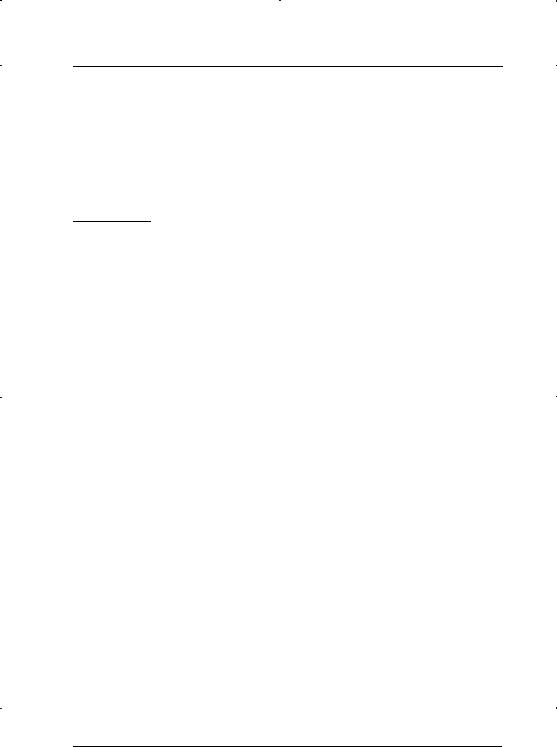
Introduction
Your new EPSON® DLQ-3000+ 24-pin dot matrix printer offers high performance with a wide range of features in a compact design. You will find the same high-quality printing and ease of operation you have come to expect from EPSON printers.
Features
Here are some of the features that make your printer a great value:
High-speed draft mode printing of up to 444 characters per second (cps) at 10 characters per inch (cpi)
The ability to handle a wide range of paper types, including single sheets, continuous paper, multi-part forms (one original plus up to six copies), labels, envelopes, postcards, overlapping forms, and continuous forms with labels
High-precision printouts even on multi-part forms, made possible by keeping the paper flat, not rolled, during printing
Easy paper handling for both single sheets and continuous paper
An AUTO function on the paper thickness lever that automatically compensates for the thickness of paper in the printer
Eight barcode fonts and four scalable fonts, as well as one draft and nine letter-quality bitmap fonts
A large printable area: 70 lines on A4 size paper and 66 lines on letter size paper
Introduction 1

Color printing with a color-ribbon cartridge (S015067).
Bidirectional communication with IEEE 1284 Nibble Mode support.
Support of advanced EPSON ESC/P 2™ commands and IBM® 2391 Plus emulation
An advanced control panel, including a display screen that provides you with current printer current status information. Also, using the control panel, you can enter SelecType mode, which enables you to make more printer settings than are available through many application programs.
An automatic interface selection feature. You can connect more than one computer at a time, and the printer switches from one to the other as it receives data.
Software, including a printer driver and a remote control panel utility that lets you change printer settings quickly and easily
For Windows 95 users, the EPSON Status Monitor utility. This program monitors printer status, alerts you when printer errors occur, and provides simple troubleshooting tips.
Options
The following options are available for your printer:
The cut-sheet feeder which automatically feeds up to 200 sheets of plain paper without reloading.
Interface cards, which are available to supplement the printer’s built-in parallel and serial interface.
2 Introduction
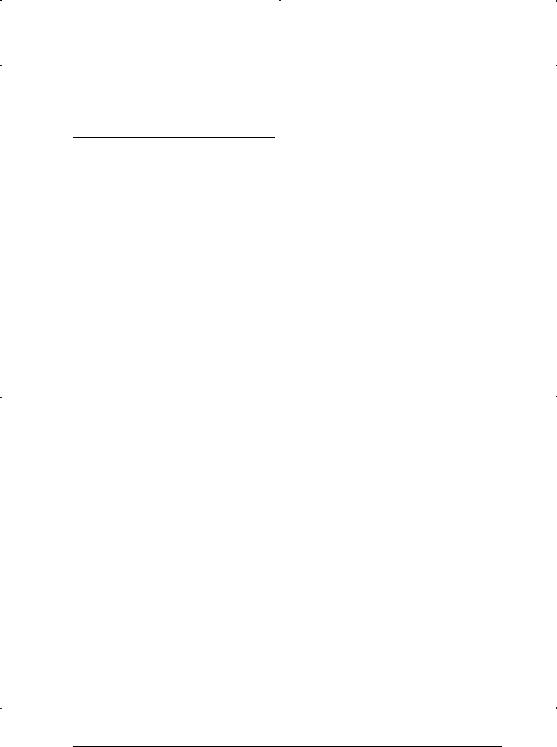
Chapter 6, “Using Printer Options,” contains detailed information about installing and using these options.
How to Use This Manual
This manual provides illustrated, step-by-step instructions for setting up and operating your printer.
Chapter 1 “Setting Up the Printer” contains information on unpacking, setting up, and connecting the printer. Be sure to read this chapter first.
Chapter 2 “Setting Up Your Software” describes how to set up your software, which includes a printer driver for Microsoft® Windows® operating systems, the EPSON Status Monitor utility for Windows 95, and two DOS-based printer utilities.
Chapter 3 “Paper Handling” explains how to load and use single sheets, continuous paper, and other types of paper.
Chapter 4 “Controlling the Printer” contains information on controlling the printer using the control panel. To change many of the printer’s default settings, see “SelecType” in this chapter.
Chapter 5 “Using EPSON Status Monitor 2” explains how to use the EPSON Status Monitor 2 utility for Windows 95.
Chapter 6 “Using Printer Options” explains how to use optional accessories with your printer.
Chapter 7 “Maintenance and Transportation” provides maintenance information, including transportation guidelines.
Chapter 8 “Troubleshooting” contains troubleshooting information. If the printer does not operate properly or the printed results are not what you expect, see this chapter for solutions.
Introduction 3
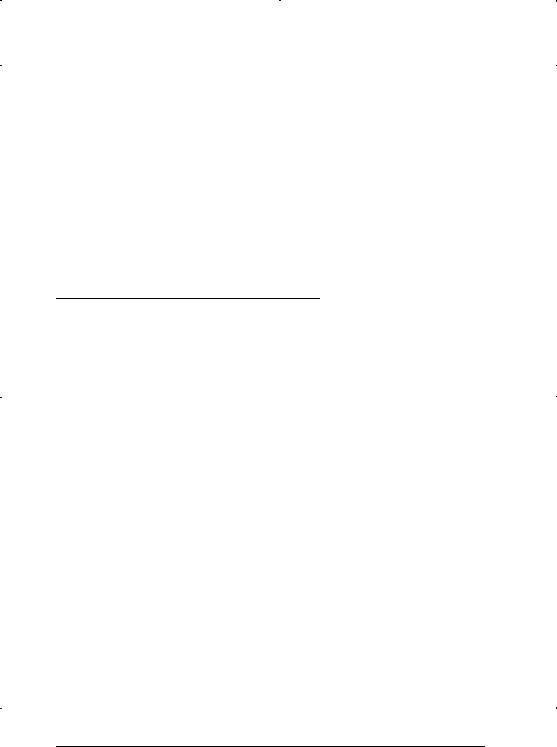
Appendix A “Specifications” provides specifications for the printer and the optional cut-sheet feeder.
Appendix B “Command Lists and Character Tables” lists the printer’s commands and character tables.
Appendix C “Contacting Customer Support” lists the best ways for getting help and more information about EPSON products and services.
A Glossary and an Index are provided at the end of this manual.
Warnings, Cautions, and Notes
w Warnings must be followed to avoid bodily injury.
c Cautions must be observed to avoid damage to your equipment.
Notes contain important information and useful tips on the operation of your printer.
4 Introduction

Chapter 1 |
|
1 |
Setting Up the Printer |
|
|
|
|
Unpacking the Printer . . . . . . . . . . . . . . . . . . . . . . . . |
1-2 |
Choosing a Place for the Printer . . . . . . . . . . . . . . . . . . |
1-3 |
Assembling the Printer . . . . . . . . . . . . . . . . . . . . . . . |
1-5 |
Installing the ribbon cartridge . . . . . . . . . . . . . . . . . |
1-5 |
Attaching the paper guides . . . . . . . . . . . . . . . . . . . |
1-8 |
Plugging In the Printer . . . . . . . . . . . . . . . . . . . . . . . |
1-9 |
Connecting the Printer to Your Computer . . . . . . . . . . . . |
1-10 |
Setting Up the Printer 1-1

This chapter describes how to set up your printer and connect it to your computer.
Unpacking the Printer
Besides this guide, your printer box should include EPSON printer software disks, a Notice Sheet, and the following items:
rear paper guide
printer
black ribbon |
|
color ribbon |
front paper guide |
optional connector
power cord
lock nuts
Note:
Depending on your printer model, the power cord may be permanently attached to the printer. Also, the shape of the power cord plug varies depending on the country in which you bought your printer; be sure the plug you have is the right one for your location.
You must remove all protective materials packed around and inside your printer before you set it up and turn on the power. Follow the directions on the Notice Sheet (packed with the printer) to remove these materials.
Save all packing and protective materials in case you need to ship the printer in the future. It should always be transported in its original packaging or equivalent materials.
1-2 Setting Up the Printer
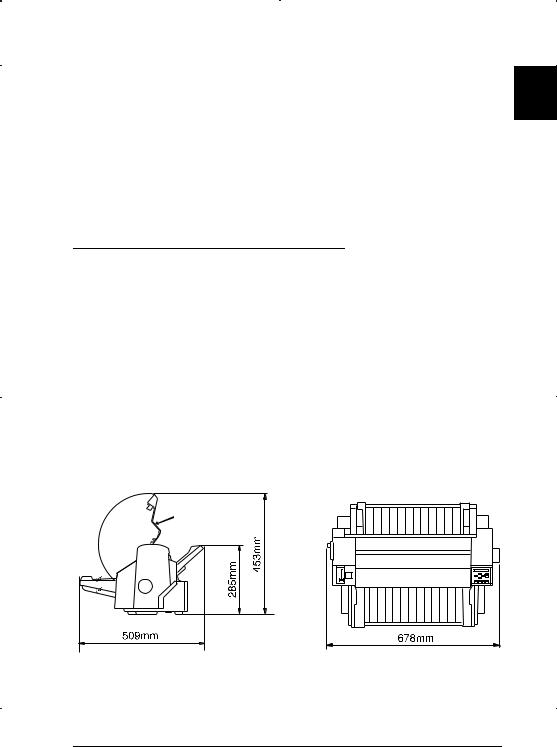
c |
Caution: |
1 |
Be sure to remove all protective materials before you turn |
on the printer.
There are several models of the printer designed for different voltages, and it is not possible to adjust the printer for use at another voltage. If the label on the back of the printer does not show the correct voltage for your country, contact your dealer.
Choosing a Place for the Printer
Follow the guidelines below when selecting a location for your printer.
Place the printer on a flat, stable surface. The printer will not operate properly if it is tilted or at an angle.
Place the printer where you can easily connect it to a network interface cable, if necessary.
Leave adequate room around the printer for easy operation and maintenance, as shown below.
printer cover |
Place the printer near a wall outlet where you easily unplug the power cord.
Setting Up the Printer 1-3

Avoid using or storing the printer in places subject to rapid changes in temperature and humidity. Also keep it away from direct sunlight, strong light, heat sources, or excessive moisture or dust.
Avoid places subject to shocks and vibrations.
Note for French-speaking users:
Placez l’imprimante près d’une prise de contact où la fiche peut être débranchée facilement.
Avoid electrical outlets controlled by wall switches or automatic timers. An interruption in power can erase information in the memory of your printer or computer. Also avoid outlets on the same circuit as large motors or other appliances that can cause voltage fluctuations.
Keep the entire computer system away from potential sources of electromagnetic interference, such as loudspeakers or the base units of cordless telephones.
Use a grounded power outlet; do not use an adapter plug.
Make sure the paper path is clear and unobstructed before you print on continuous paper. See 3-13 for details.
Using a printer stand
If you plan to use a printer stand, follow these guidelines:
Use a stand that supports at least 33 kg (72.8 lb).
Never use a stand that tilts the printer. The printer should always be kept level.
Position your printer’s power cord and interface cable so they do not interfere with paper feeding. If possible, secure the cables to a leg of the printer stand.
1-4 Setting Up the Printer
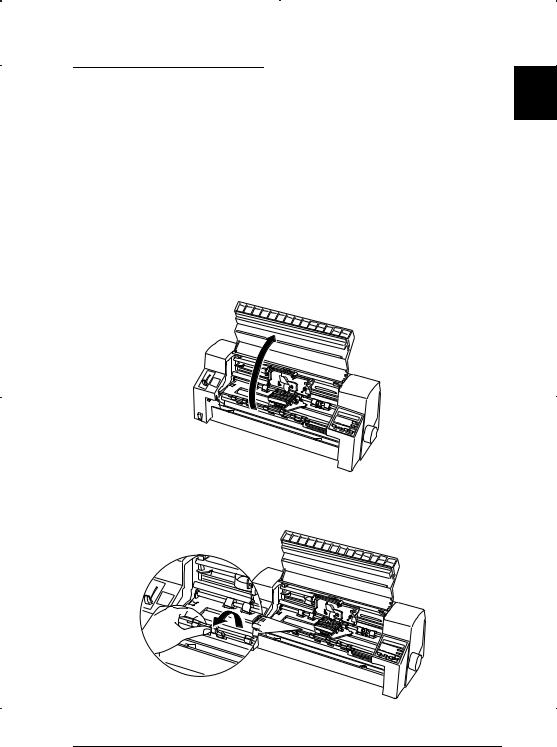
Assembling the Printer
1
Installing the ribbon cartridge
Before installing the ribbon cartridge, make sure that the power cord is not plugged into an electrical outlet.
To install the ribbon cartridge, remove it from its packaging and then follow these steps:
1.Hold the center of the front edge of the printer cover (not the right side), and lift gently up and away from you.
2. Open the paper bail.
Setting Up the Printer 1-5
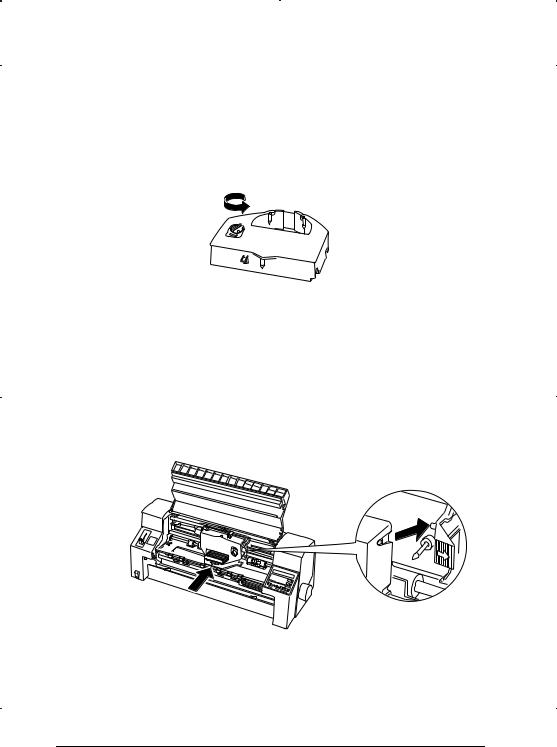
wWarning:
Never move the print head while the printer is turned on; this can damage the printer.
3.Turn the ribbon-tightening knob in the direction of the arrow to take up any slack in the ribbon.
4.Hold the ribbon cartridge with the exposed ribbon down and the ribbon-tightening knob facing you.
As shown below, guide the ribbon under the print head, and snap the cartridge into place from left to right so that the tabs on both sides of the cartridge fit into the notches in the cartridge holder. Then pivot the bottom of the cartridge into place.
1-6 Setting Up the Printer
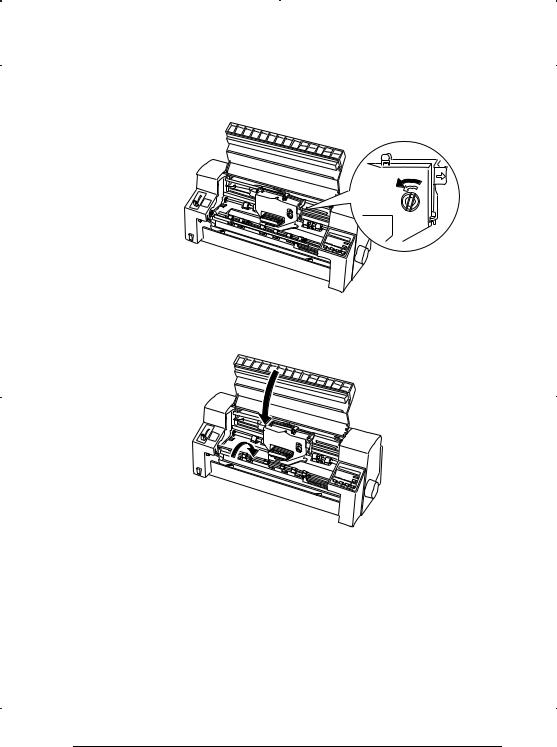
5. Turn the ribbon-tightening knob again to remove any slack |
1 |
|||||||
in the ribbon and to make sure the ribbon moves freely. |
||||||||
|
||||||||
|
|
|
|
|
|
|
|
|
|
|
|
|
|
|
|
|
|
|
|
|
|
|
|
|
|
|
|
|
|
|
|
|
|
|
|
6. Close the paper bail and the printer cover.
Setting Up the Printer 1-7

Attaching the paper guides
To attach the front and rear paper guides, follow these steps.
1.Slide the edge guides slightly to the center. Hold the front paper guide horizontally with both hands. Slide the slots on both sides of it onto the mounting pegs in the printer as shown below. Then lower it until it locks into place.
2.In the same way, place the rear paper guide clips over the mounting pins ¬ and bar -; then lower it until it locks into place.
1-8 Setting Up the Printer
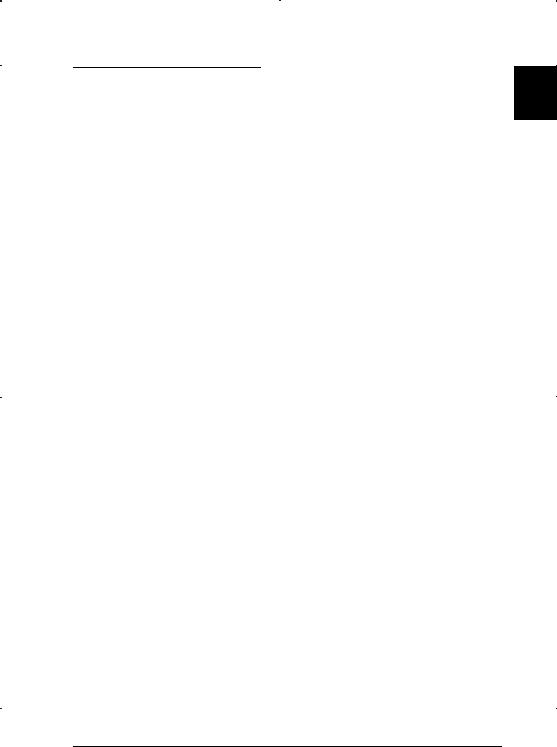
Plugging In the Printer
1
1.Make sure the printer is turned off. The printer is off when the N side of the power switch is pressed.
2.Check the label on the back of the printer to make sure its voltage matches that of your electrical outlet. Also make sure the plug on your printer’s power cord matches your electrical outlet.
cCaution:
It is not possible to change the printer’s voltage. If the rated voltage and your outlet voltage do not match, contact your dealer for assistance. Do not plug in the power cord.
3.If the power cord is not attached to the printer, plug the appropriate end into the AC inlet on the back of the printer.
4.Plug the power cord into a properly grounded electrical outlet.
Setting Up the Printer 1-9
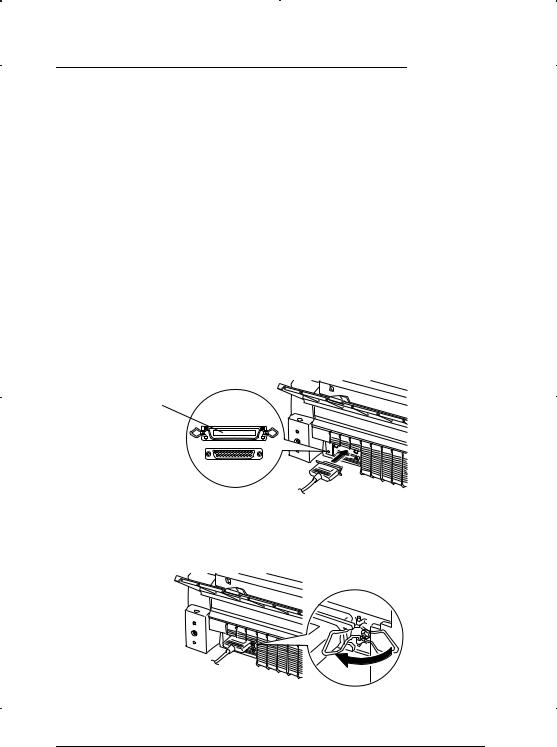
Connecting the Printer to Your Computer
Your printer has two separate interface connections: an IEEE-1284 compatible parallel interface and an EIA-232D serial interface. See page A-18 for more information.
If your computer requires a different type of printer interface, see page 6-11 for a list of compatible, optional interfaces.
To connect the printer to your computer using the built-in parallel or serial interface, follow the steps below.
1.Make sure both the printer and computer are turned off.
2.Plug the cable connector securely into the appropriate interface connector as shown below.
parallel interface
parallel interface connector
Squeeze the wire clips together until they lock in place on both sides of the connector.
1-10 Setting Up the Printer
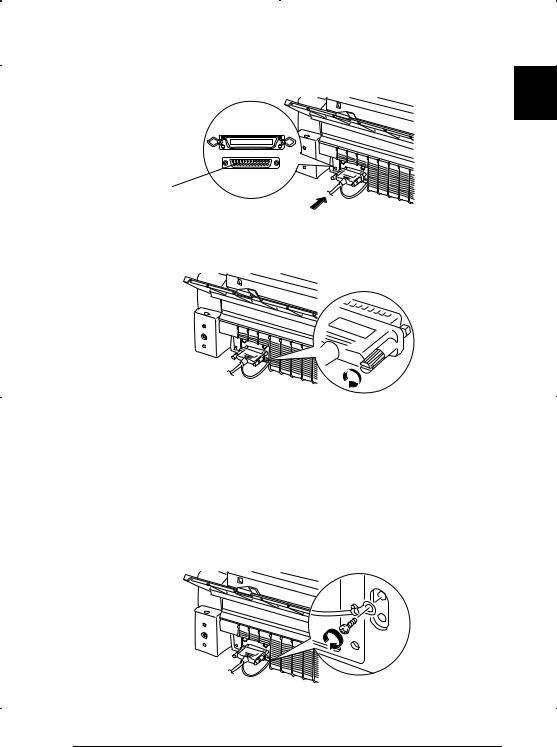
serial interface
1
serial interface connector
Tighten the screws on both sides of the connector.
Note:
If the screws that come with the cable do not fit into the connector lock nuts on the interface, replace the lock nuts with the optional lock nuts provided with the printer.
3.If your cable has a ground wire, connect it to the printer’s ground connector as shown below.
4. Plug the other end of the cable into the computer.
Setting Up the Printer 1-11

Before using the printer’s serial interface with SelecType, make sure that the printer’s serial communication settings match those on your computer. See “SelecType” on page 4-8 for more information.
Now that the printer hardware is set up, see Chapter 2 for instructions on installing and using the printer software.
1-12 Setting Up the Printer
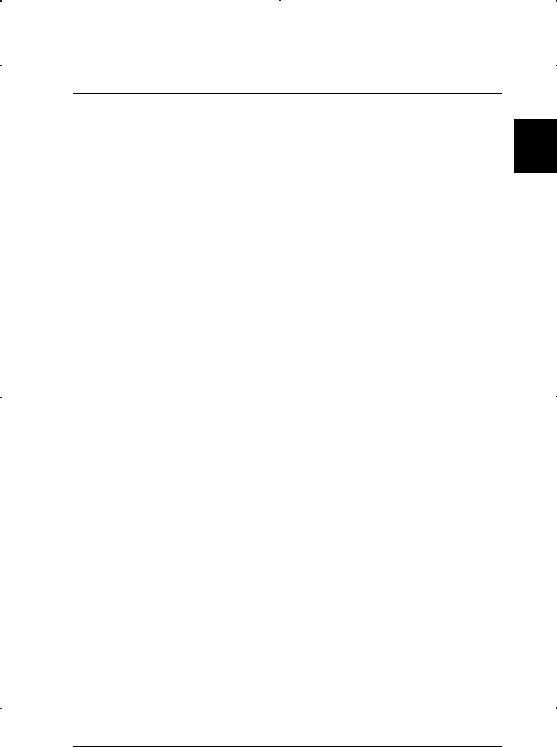
Chapter 2
Setting Up Your Software
2
For Windows 95 Users . . . . . . . . . . . . . . . . . . . . . . . |
2-2 |
Installing the printer driver using My Computer . . . . . . |
2-2 |
Installing the printer driver using plug-and-play . . . . . . |
2-3 |
Using the printer driver . . . . . . . . . . . . . . . . . . . . |
2-5 |
Installing EPSON Status Monitor 2 . . . . . . . . . . . . . . |
2-8 |
For Windows 3.1 Users . . . . . . . . . . . . . . . . . . . . . . . |
2-9 |
Installing the printer driver using Program Manager . . . |
2-9 |
Using the printer driver . . . . . . . . . . . . . . . . . . . . |
2-10 |
For Windows NT 4.0 Users . . . . . . . . . . . . . . . . . . . . |
2-13 |
Installing the printer driver . . . . . . . . . . . . . . . . . . |
2-13 |
Using the printer driver . . . . . . . . . . . . . . . . . . . . |
2-14 |
For Windows NT 3.5x Users . . . . . . . . . . . . . . . . . . . . |
2-17 |
Installing the printer driver . . . . . . . . . . . . . . . . . . |
2-17 |
Using the printer driver . . . . . . . . . . . . . . . . . . . . |
2-18 |
For DOS Program Users . . . . . . . . . . . . . . . . . . . . . . |
2-21 |
Installing the printer driver . . . . . . . . . . . . . . . . . . |
2-21 |
Using the printer utilities . . . . . . . . . . . . . . . . . . . |
2-22 |
Setting Up Your Software 2-1
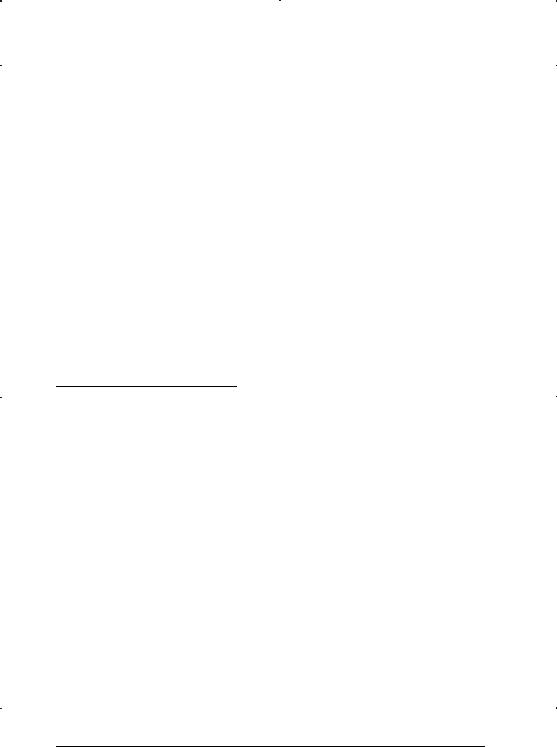
The EPSON printer software that comes with your printer includes the printer driver software, a status monitor utility for use with Windows 95, and two DOS-based utilities.
A printer driver is software that allows your computer to control the printer. You need to install the printer driver so your software applications can take full advantage of the printer’s capabilities.
For instructions on installing the printer software, see the next section if you are using Windows 95, or see page 2-9 for Windows 3.1, page 2-13 for Windows NT 4.0, page 2-17 for Windows NT 3.5x, or page 2-21 for DOS programs.
Note:
Before you install the printer software, it is best to make backup copies of the EPSON printer software disks.
For Windows 95 Users
Follow the steps below to install the printer driver for Windows 95. For instructions on installing the EPSON Status Monitor 2 utility, see page 2-8.
Installing the printer driver using My Computer
1.Make sure Windows 95 is running and the printer is off.
2.Insert Disk 1 of your printer driver software in a disk drive. Double-click the My Computer icon, and then double-click the drive in which you inserted the disk.
2-2 Setting Up Your Software
